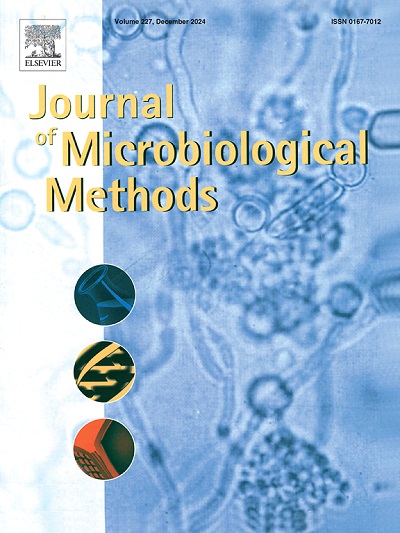Optical time-lapse microscopy for rapid assessment of microbial quality in hygroscopic food samples
IF 1.7
4区 生物学
Q4 BIOCHEMICAL RESEARCH METHODS
引用次数: 0
Abstract
In the food industry, time-to-result is crucial for faster release of products, minimising recalls, mitigation of microbial contamination problems and, ultimately, food safety. Carrageenan is isolated from red seaweed (Rhodophyta) and applied in various foods and beverages as a gelling, thickening, texturing, or stabilising agent due to its hygroscopic properties. Currently, the standard industry plate count method entails a one-hundred-fold dilution of the sample before mixing with molten agar for assessing the level of microbial contamination in carrageenan samples prior to business-to-business shipment. However, even at this dilution, carrageenan swells, forms clumps, clogs pipettes, and leaves thick gel structures, bubbles, and debris in agar plates causing microbial enumeration to be challenging and subject to human error. Here, we report, for the first time, the application of mini agar plates monitored by the automated time-lapse microscopy IntuGrow solution to assess the microbiological quality in the challenging food ingredient. Without dilution of the food sample, the carrageenan powder is scattered between two layers of Plate Count Agar to enumerate bacteria within 12–20 h, while enumeration by traditional plate counts requires 72 h. A DELAY algorithm for optical time-lapse microscopy was developed and added to IntuGrow analysis software to suppress the effects of swelling and enhance detection of the presence of growing microbial colonies by normalising the background using previous images. Time-lapse microscopy image-based monitoring made it possible to obtain results from carrageenan samples that could not be obtained by traditional plate counts due to swarming bacteria. Comparison between the two methods showed a nearly perfect Demings slope of 0.96, while an observed bias of −0.33 log CFU/g indicated that IntuGrow counts were lower than traditional plate counts. This is likely due to carrageenan artefacts being counted as colonies in the latter plates. The ability of IntuGrow to enumerate bacteria in challenging food ingredients such as carrageenan implies that the technology should be easy to apply for easy-to-dilute samples or non-hydrocolloid powders. Further testing in an industrial setting by different operators should be used to validate the reproducibility of the method.
吸湿性食品样品中微生物质量快速评价的光学延时显微镜。
在食品行业,时间到结果对于更快地发布产品,最大限度地减少召回,减轻微生物污染问题以及最终的食品安全至关重要。卡拉胶是从红海藻(红藻)中分离出来的,由于其吸湿性,它可以作为胶凝剂、增稠剂、质地剂或稳定剂应用于各种食品和饮料中。目前,标准的工业平板计数方法需要在与熔融琼脂混合之前将样品稀释100倍,以便在企业对企业运输之前评估卡拉胶样品中的微生物污染水平。然而,即使在这种稀释下,卡拉胶也会膨胀,形成团块,堵塞移液器,并在琼脂皿中留下厚厚的凝胶结构,气泡和碎片,导致微生物计数具有挑战性并容易受到人为错误的影响。在这里,我们首次报道了由自动延时显微镜IntuGrow溶液监测的微型琼脂板的应用,以评估具有挑战性的食品成分中的微生物质量。在不稀释食物样品的情况下,将卡拉胶粉分散在两层平板计数琼脂(PCA)之间,在12-20 h内枚举细菌,而传统平板计数需要72 h。我们开发了一种用于光学延时显微镜的DELAY算法,并将其添加到IntuGrow分析软件中,通过使用先前的图像对背景进行归一化,来抑制肿胀的影响,并增强对生长微生物菌落存在的检测。基于延时显微镜图像的监测使得从卡拉胶样品中获得由于细菌聚集而无法通过传统平板计数获得的结果成为可能。两种方法的比较显示,Demings斜率接近完美,为0.96,而观察到的偏差为-0.33 log CFU/g,表明IntuGrow计数低于传统平板计数。这可能是由于卡拉胶人工制品在后一个板块中被算作菌落。IntuGrow能够在具有挑战性的食品成分(如卡拉胶)中枚举细菌,这意味着该技术应该易于应用于易于稀释的样品或非水胶体粉末。应在工业环境中由不同操作人员进行进一步测试,以验证该方法的可重复性。
本文章由计算机程序翻译,如有差异,请以英文原文为准。
求助全文
约1分钟内获得全文
求助全文
来源期刊

Journal of microbiological methods
生物-生化研究方法
CiteScore
4.30
自引率
4.50%
发文量
151
审稿时长
29 days
期刊介绍:
The Journal of Microbiological Methods publishes scholarly and original articles, notes and review articles. These articles must include novel and/or state-of-the-art methods, or significant improvements to existing methods. Novel and innovative applications of current methods that are validated and useful will also be published. JMM strives for scholarship, innovation and excellence. This demands scientific rigour, the best available methods and technologies, correctly replicated experiments/tests, the inclusion of proper controls, calibrations, and the correct statistical analysis. The presentation of the data must support the interpretation of the method/approach.
All aspects of microbiology are covered, except virology. These include agricultural microbiology, applied and environmental microbiology, bioassays, bioinformatics, biotechnology, biochemical microbiology, clinical microbiology, diagnostics, food monitoring and quality control microbiology, microbial genetics and genomics, geomicrobiology, microbiome methods regardless of habitat, high through-put sequencing methods and analysis, microbial pathogenesis and host responses, metabolomics, metagenomics, metaproteomics, microbial ecology and diversity, microbial physiology, microbial ultra-structure, microscopic and imaging methods, molecular microbiology, mycology, novel mathematical microbiology and modelling, parasitology, plant-microbe interactions, protein markers/profiles, proteomics, pyrosequencing, public health microbiology, radioisotopes applied to microbiology, robotics applied to microbiological methods,rumen microbiology, microbiological methods for space missions and extreme environments, sampling methods and samplers, soil and sediment microbiology, transcriptomics, veterinary microbiology, sero-diagnostics and typing/identification.
 求助内容:
求助内容: 应助结果提醒方式:
应助结果提醒方式:


